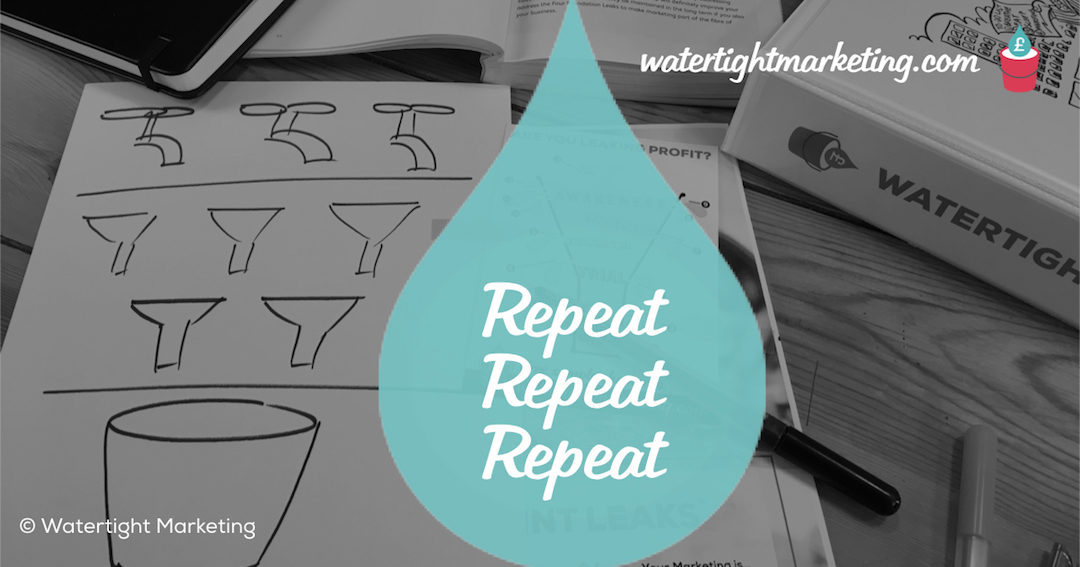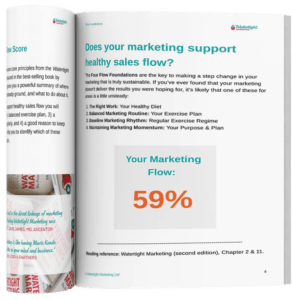Are you worried about repetition in marketing? We often encounter an uneasiness and sense of mounting pressure in businesses where marketing includes putting out high quality content. Perhaps they’ve made a commitment to a baseline of weekly blogs, monthly videos, quarterly paper, etc. A feeling starts to creep in. It’s a bit how I feel about the ironing pile… it just keeps building up and waving at me as yet another task that needs my attention. Do you know this feeling?
The mounting pressure to continually create new content
This comes from the perception that you constantly need to be coming up with new material for your marketing. I’ve heard this referred to as feeding the content monster… Let me ease your burden by giving you explicit encouragement, or permission if you need it, to repeat yourself. Often!
Six reasons repetition in marketing is good
1) Repetition is essential to learning
Let me ask:
- How many times did you need to repeat your times tables to remember them?
- Did your kids master the art of walking on their first attempt?
- Did you do better in exams for which you revised?
I’m going to take a bet that success in these contexts meant more than a little repetition. The same is true for people in your audience. The process of a considered buying decision is one of discovery and making informed choices. Your marketing is part of an educative process in which the buyer is learning about their needs, the possible solutions, and the likely outcomes. Repetition is a key technique in learning, which makes it a key technique in marketing.
See: Leak 10 – When in Chapter 2 and 8 of Watertight Marketing
2) Action rarely happens on the first encounter
Okay, let’s go back to the ironing pile… I can’t be the only one who takes a few days to build up the irritation factor to the appropriate level to make me actually do the dreaded ironing. I can walk past it more times than I care to admit before actually taking action. This happens in buying decisions too.
You might see a paper and think it looks interesting, but get distracted. You might see it again and download it… but pop it in the ‘read it later’ list. Then another prompt about the same piece might trigger you to actually read it. Your buyers are busy. Repetition is important as a reminder to take action.
3) You can freshen up old content with a new angle
Another couple of questions for you:
- Have you ever read two articles on the same topic?
- Or, maybe more than one business book?
Some of the books and articles I enjoy the most are those that shine fresh light on an old idea. They’re articles that have me smiling from cheek to cheek with recognition and agreement. It’s very rare for me to initially enjoy something that’s a wholly alien idea. In marketing, this means having repeating topics and themes. You can add interest and variety by taking a new angle, rather than by saying something entirely new each time.
Looking for inspiration for that new angle? Check out our A to Z of Content Marketing Ideas
4) It’s new to each new person who encounters it
A copy of Watertight Marketing has sold on average every six hours, every day, for the last four years. Naturally, it’s a different person each time… for whom it is a new discovery. If I had taken it off sale after a couple of weeks because I thought my audience was expecting something new from me, that would have lost me all those new readers.
It is absolutely fine to recycle quality content from your archive. It’s more than fine! It’s efficient and effective. Go on, have a look back… I bet you have something tucked away that more people (including you) could get enormous value from. Dust it down and get it out there.
5) People love knowing what to expect from you
I’m pretty excited to hear that 80s pop legends, Bananarama, are getting back together for a tour of the country. Now, imagine how miffed ticket holders would be if they didn’t play their classic tracks, preferring instead to play stuff from an as yet unknown new album. Some artists may talk about being bored of playing that one song that everyone knows… but it does pay the mortgage.
Buyers build up expectations about organisations they interact with. If there’s not a level of consistency and familiarity about your content, it erodes trust. A healthy bit of repetition helps people to build up a picture of who and what you are all about.
See: Leak 12 – What in Chapter 2 and 8 of Watertight Marketing
6) Great content doesn’t date, it puts down roots
And, here’s the biggie. At the heart of your marketing should be some cornerstone content. These form the foundations of your messaging. These should be deep, considered, and compelling pieces that do not date. If you spend time creating something of true value that isn’t attached to something inherently transient, it puts down roots and becomes an evergreen part of your marketing.
Of course, it’s also great to have some timely content. This might include comment on a news story, tips on new technology, or a briefing on an emerging trend. These are like a game of Pooh Sticks… you drop them in the stream of content and they pass quickly. These lighter pieces only really start to be effective when they form pointers to the stuff of substance. And, that is core content that you should be known for… like, say, a timeless book. These are not things you say once and move on. You repeat, repeat, and then repeat some more.
Put that content monster on a diet. It does not need constant feeding. A regular pattern of favourites is absolutely fine.
© Bryony Thomas – The Watertight Marketer
Grab your copy of our most popular download – The A to Z of Content Marketing – to give you over 140 ideas for new angles on your best ideas.

Bryony Thomas
Author & Founder, Watertight Marketing
Bryony Thomas is the multi-award winning creator of the Watertight Marketing methodology, captured in the best-selling book of the same name. Bryony is a popular professional speaker for entrepreneurial audiences. Bryony's impressive career includes heading up the Microsoft account in the UK aged 26, and securing the role of divisional director of marketing for FTSE 100, Experian, aged 28.


